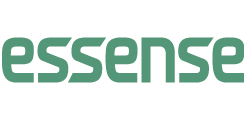
How do you explain the basic principles of Service Design to a diverse crowd of everyday people? This is the challenge we at Essense faced when we decided to set up a stand to showcase our work during the Dutch Design Week. Together with a colleague, we were asked to design an engaging experience for the visitors while teaching them a thing or two about our process.
The Dutch Design Week is the biggest annual design event in Northern Europe, presenting work and ideas of more than 2600 designers to more than 335,000 visitors from home and abroad. Being our first year at the event, we wanted to help visitors learn about Service Design in a way that they can easily relate to. At the same time, we wanted to highlight our (way of) work, so that professionals who want to work with us or for us have a better idea of how we provide value.
As with any design challenge, we set about defining our goals and understanding the limitations posed by the format of the stand. We aimed to create an engaging experience by having some level of interaction with our visitors, and we decided to use the “Passenger Experience” as our theme, since it’s a subject most people will find easy to relate to, and it provides us an opportunity to nicely showcase some of the work we’ve done in the past for organizations like Schiphol Airport or the Dutch Railways Company.
The left side of the stand highlights how we collect data from real users, and visualize it in such a way that it helps us to identify pain points and opportunities. Using coloured strings on a matrix of nails, we ask visitors to “plot” their experience, on a scale of 1 (bad) to 10 (good), for each of the 8 stages identified which are common to all 3 transportation modes. Each colour represents one of the 3 modes. As a way to inspire visitors, 3 journeys are printed in the background, with a selection of quotes for some of the journey points.
The middle part highlights how we create solutions for identified pain points and opportunities. We ask visitors to contribute with their own solutions to any of the stages by drawing or writing on papers we provide them with. The papers may contain some specific trigger questions dealing with the multi-channel nature of service design (e.g. “How would you improve the online ticket experience?” and “How would you improve the kiosk ticket experience?”. Some of the spaces do not have papers and instead showcase a solution that Essense has developed for a client.
The far right of the stand is aimed at design professionals and companies interested in our services. Company profile, with information about our team and way of working, plus examples from real life projects in which we’ve successfully applied a service design approach to create value for our clients.
The stand had an overwhelmingly positive response from our visitors, who flocked full of curiosity towards our colorful wall to better understand what it was all about. People enthusiastically plotted their own experience with the different transportation modes, and the visual created on the wall by the multitude of strings tangled together allowed them to understand how the experience of one individual differs from others, but how by aggregating all of the results together, certain patterns and pain points become more evident.
Asking people to draw or write their ideas on how to improve any of the touchpoints also proved to be an engaging activity for visitors of all ages. They let their creativity loose and provided us (and fellow visitors) with some really inspiring ideas, showing that efforts in co-creation can provide organizations with out-of-the-box concepts and innovations.
At the end of the day, our stand also proved to be a successful showcase for our business relations, since the simplicity of our presentation helped to illustrate the business value that a Service Design approach can have on any organization, and we managed to create quite a few leads.
To learn more about the experience of our stand make sure to read our medium article “Crowd Mapping the Passenger Experience“.

